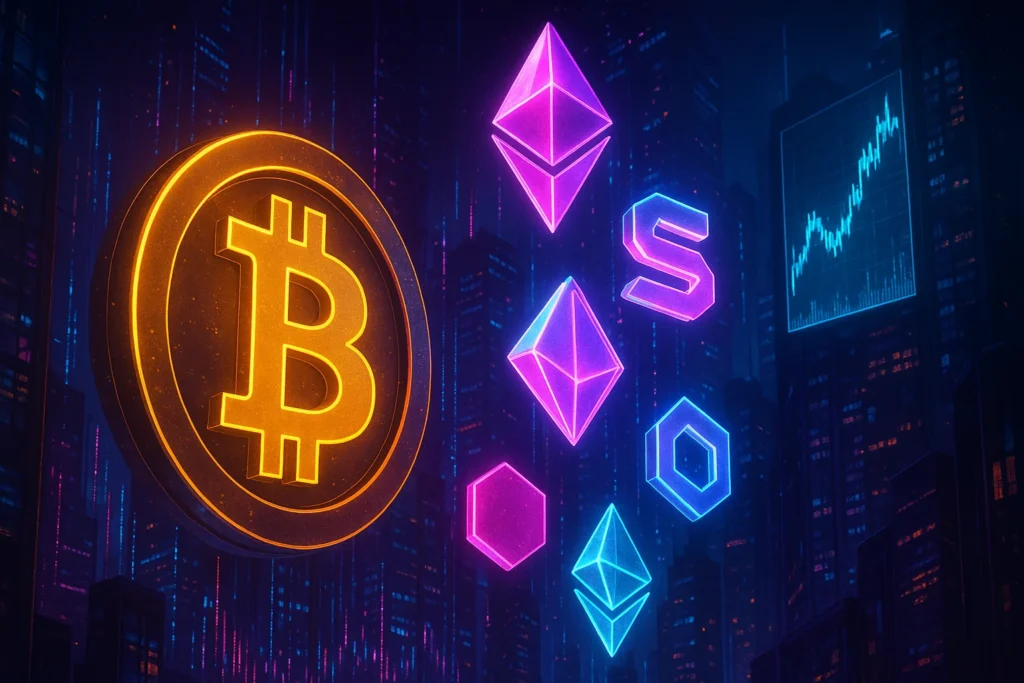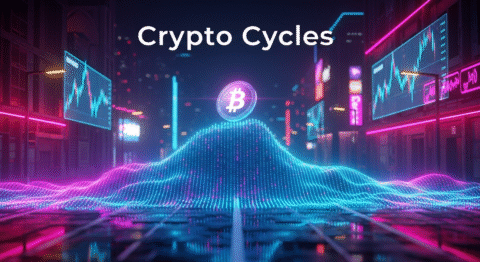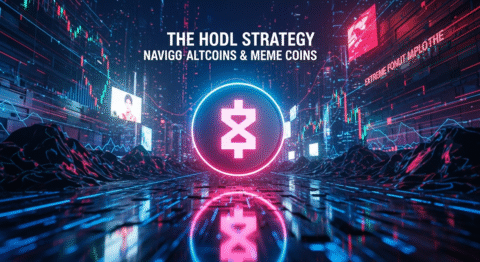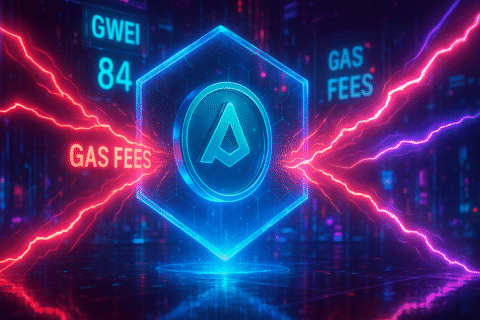Navigating the Digital Frontier
Could These Altcoins Outshine Bitcoin in the Next Bull Run?
The cryptocurrency market is a dazzling, volatile landscape, a digital frontier where fortunes can be made and lost with startling speed. But beyond the familiar reign of Bitcoin, a universe of lesser-known digital assets beckons. For those asking, what are altcoins and whether they hold the key to the next significant leap in crypto wealth, this guide is your compass. As of the latest market data, altcoins represent a staggering portion of the total cryptocurrency market capitalization, constantly evolving and offering unique utility and investment opportunities.
Crypto Market Overview: A Shifting Sands of Opportunity
The cryptocurrency market is in a constant state of flux, with Bitcoin often setting the pace, but it’s the altcoin market that truly showcases the innovation and diversification within the digital asset space. Currently, we’re observing a dynamic environment where established altcoins are solidifying their ecosystems, while nascent meme coins and utility tokens are capturing significant attention, often driven by community sentiment and innovative marketing.
Recent trends indicate a growing institutional interest in certain altcoins with strong use cases in areas like decentralized finance (DeFi), non-fungible tokens (NFTs), and supply chain management. Simultaneously, meme coins, initially born from internet culture, continue to demonstrate their potential for rapid price appreciation, albeit with commensurate risk. Crypto airdrops, a powerful tool for user acquisition and distribution, are also seeing a resurgence, rewarding early adopters and fostering community growth. Key market indicators, such as trading volumes, social media sentiment, and developer activity, all point towards a vibrant and evolving altcoin landscape, pregnant with both opportunity and considerable risk. Understanding these shifts is crucial for anyone looking to make informed decisions in this space.
The Core Concepts: Unpacking the Altcoin Universe
what are altcoins / Meme Coins / Airdrops?
At its core, “altcoin” is a portmanteau of “alternative coin.” In essence, what are altcoins? They are any cryptocurrencies other than Bitcoin. Bitcoin, launched in 2009, was the pioneer, establishing the foundational principles of blockchain technology and decentralized digital currency. As the technology matured and the demand for different functionalities grew, developers began creating new cryptocurrencies with unique features, purposes, and technological underpinnings.
Meme coins, a sub-category of altcoins, are digital currencies often inspired by internet memes, jokes, or social media trends. While they might initially lack a clear utility, their value can skyrocket through strong community backing and viral marketing campaigns. Examples like Dogecoin and Shiba Inu have demonstrated this phenomenon.
Crypto airdrops, on the other hand, are a marketing strategy where new cryptocurrencies distribute tokens to a wide audience for free, or in exchange for basic tasks like social media promotion or holding another cryptocurrency. This is often done to generate awareness, build a user base, and decentralize token distribution efficiently. Think of it as a digital giveaway designed to kickstart a project’s community and adoption.
Key Components & Technologies
The engine driving most altcoins, meme coins, and the underlying infrastructure for airdrops is blockchain technology. This distributed ledger technology ensures transparency, security, and immutability of transactions. However, altcoins often innovate by employing different blockchain architectures or consensus mechanisms:
- Proof-of-Stake (PoS) vs. Proof-of-Work (PoW): While Bitcoin uses PoW (requiring significant energy for mining), many altcoins opt for PoS, where validators are chosen based on the number of coins they hold and are willing to “stake.” PoS is generally more energy-efficient and can allow for faster transaction speeds.
- Smart Contracts: Platforms like Ethereum pioneered smart contracts, self-executing contracts with the terms of the agreement directly written into code. This enables a vast array of decentralized applications (dApps), DeFi protocols, and NFTs, powering many advanced altcoins.
- Interoperability Protocols: As the crypto space expands, technologies that allow different blockchains to communicate with each other are becoming increasingly important for altcoin ecosystems, enabling seamless asset transfer and cross-chain functionalities.
- Decentralized Finance (DeFi): This is a rapidly growing sector within altcoins, aiming to recreate traditional financial services (lending, borrowing, trading) on a blockchain without intermediaries. Altcoins are central to DeFi, acting as collateral, governance tokens, and utility assets within these protocols.
- Token Standards (e.g., ERC-20, BEP-20): These are technical specifications that ensure interoperability between smart contracts and decentralized applications. Understanding these standards is crucial for many altcoin transactions and interactions within decentralized ecosystems.
The Data-Driven Perspective: Gauging the Altcoin Market
Understanding the performance and health of altcoins requires a dive into their market data and underlying tokenomics.
Market Data & Trends
The altcoin market is characterized by its dynamism. While Bitcoin’s dominance has fluctuated, altcoins have consistently shown potential for higher growth and faster price movements.
- Market Capitalization: As of recent data, altcoins collectively represent a significant chunk of the total cryptocurrency market cap, often exceeding 50%. This indicates their substantial influence and the sheer volume of digital assets beyond Bitcoin.
- Performance Metrics: Analyzing metrics like 24-hour trading volume, market cap growth over time, and percentage changes against fiat currencies (like USD) and Bitcoin (BTC) provides a clear picture of their current standing. For instance, tracking the performance of Top altcoins can reveal emerging trends in sectors like DeFi, NFTs, or metaverse projects.
- Volatility: Historically, altcoins have exhibited higher volatility than Bitcoin. This means their prices can swing more dramatically in shorter periods. Data analysis often reveals that while higher risk is present, the potential for reward can also be amplified. Studies often show that during bull cycles, many altcoins can outperform Bitcoin in terms of percentage gains.
- Airdrop Performance: Data on airdrops shows varying success rates. Successful airdrops often correlate with strong community engagement post-distribution and the utility of the dropped token. Projects that conduct airdrops and see their tokens listed on reputable exchanges often experience initial price spikes.
Tokenomics & Market Health
Tokenomics, the economic model of a cryptocurrency, is critical for assessing its long-term viability. For altcoins and meme coins, this includes:
- Token Supply: Is the supply fixed (like Bitcoin’s 21 million) or inflationary? A fixed supply can create scarcity, potentially driving up value. An inflationary supply might require constant demand to offset token creation.
- Distribution: How were the tokens initially distributed? Was it through a fair launch, an ICO (Initial Coin Offering), a private sale, or an airdrop? A widely distributed token can indicate decentralization and a broader community base.
- Utility: Does the token have a specific use case beyond speculation? Can it be used for transaction fees, staking, governance, or accessing services within a platform? Tokens with strong utility are generally considered more robust.
- Vesting Schedules: For tokens allocated to founders and early investors, vesting schedules can prevent large sell-offs that could crash the price. Data on vesting can indicate long-term commitment from the project team.
- Staking Rewards & Yields: For PoS altcoins, staking rewards contribute to the token’s utility and can incentivize holding. Analyzing yield percentages and the mechanisms behind them is important.
- Community Engagement: For meme coins especially, but also for utility altcoins, the strength and activity of the community on platforms like Reddit, Twitter, and Discord are key indicators of potential value and market support. High social media sentiment can often precede significant price pumps.
A healthy tokenomic model balances supply and demand, incentivizes participation, and provides clear utility or value proposition, which is crucial for any altcoin looking for long-term sustainability.
Risks, Challenges & Competition
The allure of high returns from altcoins comes with a significant shadow of risk. Understanding these pitfalls is as vital as recognizing the potential.
Risks of Altcoins and Meme Coins
- Extreme Volatility: As mentioned, altcoins can experience much larger price swings than Bitcoin. This means a rapid ascent can be followed by an equally rapid and dramatic fall, leading to substantial losses for unprepared investors. Data consistently shows altcoins are generally more volatile than Bitcoin.
- Lower Liquidity: Many altcoins have lower trading volumes compared to Bitcoin, meaning it can be harder to buy or sell large amounts without significantly impacting the price. This can lead to slippage and difficulty exiting positions quickly.
- Project Failure and Scams: The cryptocurrency space, especially the altcoin market, is rife with projects that fail due to poor execution, lack of funding, or outright scams (often termed “rug pulls”). Data from blockchain security firms often highlights the significant value lost to scams annually.
- Security Vulnerabilities: While blockchain itself is secure, the smart contracts and underlying code of altcoins can have bugs or vulnerabilities that malicious actors can exploit, leading to theft of funds. Several high-profile hacks have targeted altcoin platforms.
- Regulatory Uncertainty: The regulatory landscape for cryptocurrencies is still evolving globally. Changes in regulations could impact the legality or trading of certain altcoins in different jurisdictions, creating uncertainty for investors.
- Lack of Intrinsic Value: Many meme coins, and even some utility tokens, may lack a solid underlying value proposition or a clear path to adoption. Their price appreciation is often driven purely by speculation and hype, making them exceptionally risky.
How Do Altcoins Stack Up Against Competitors?
When considering altcoins, it’s useful to compare them not just to Bitcoin but also to other altcoins within their respective niches. Here’s a generalized comparison:
| Feature/Attribute | Bitcoin (BTC) | Leading Altcoins (e.g., ETH, SOL, ADA) | Meme Coins (e.g., DOGE, SHIB) |
|---|---|---|---|
| Primary Use Case | Store of Value, Digital Gold | Smart Contracts, DeFi, NFTs, dApps, Ecosystems | Community, Speculation, Viral Hype |
| Technology Innovation | Foundational Blockchain, PoW | Advanced Smart Contracts, PoS, Scalability | Often simple, built on existing platforms |
| Market Cap Dominance | Highest | Significant, but less than BTC | Variable, can be large for popular ones |
| Volatility | High, but generally lower than most altcoins | Very High | Extremely High |
| Transaction Speed | Relatively slow | Variable, many faster than BTC | Variable, depends on underlying blockchain |
| Energy Consumption | High (PoW) | Significantly lower (PoS) | Low (if built on PoS or simple chains) |
| Risk Profile | High | Very High | Extremely High |
| Community Strength | Strong, established | Strong, often developer-driven & user-based | Extremely strong, often meme-driven |
| Regulatory Scrutiny | High, but generally more accepted | Increasing scrutiny, especially for DeFi | Increasing scrutiny due to speculative nature |
This table highlights that while Bitcoin remains the benchmark for digital scarcity and store of value, altcoins offer a diverse range of functionalities and technological advancements. Meme coins, while potentially rewarding, operate at a far higher risk bracket due to their speculative foundation.
The Future Outlook: What’s Next for Altcoins / Meme Coins / Airdrops?
The trajectory of altcoins, meme coins, and airdrops is intrinsically linked to the broader evolution of blockchain technology and digital assets.
What’s Next for Altcoins / Meme Coins / Airdrops?
- Further Decentralization and Utility: We will likely see a continued push for altcoins to offer tangible utility beyond speculative trading. Projects that solve real-world problems, enhance efficiency in existing industries, or provide innovative solutions in areas like DeFi, supply chain, identity management, and gaming will gain prominence. Data suggests a growing investor preference for utility-driven projects.
- Interoperability and Cross-Chain Solutions: As the blockchain ecosystem fragments into various specialized networks, the demand for seamless interoperability will intensify. Altcoins that facilitate communication and asset transfer between different blockchains are well-positioned for growth.
- Mainstream Adoption of DeFi and NFTs: The continued development and user-friendliness of DeFi platforms and NFT marketplaces will drive greater adoption of the altcoins that power these ecosystems. Expect to see more traditional financial institutions explore DeFi integration.
- Regulatory Clarity: As governments worldwide grapple with how to regulate digital assets, increased regulatory clarity, while potentially challenging for some projects, could also legitimize the market and pave the way for broader institutional and retail adoption of altcoins.
- Evolved Airdrop Strategies: Airdrops will likely become more sophisticated, moving beyond simple giveaways to reward active participation in ecosystems, contribute to governance, or incentivize specific behaviors that benefit the network. Data will be crucial in identifying truly valuable airdrops versus spam.
- Meme Coins’ Enduring Appeal (with Caution): While exceptionally risky, meme coins are likely to persist due to their strong community aspect and the entertainment value they provide. However, their long-term viability will increasingly depend on whether they can develop any form of utility or governance beyond pure speculation.
The future of altcoins is one of diversification, specialization, and increasing integration into various aspects of the digital and physical world. For investors, this means a constantly evolving landscape requiring diligent research and risk management.
Conclusion
The world of what are altcoins is vast, exciting, and undeniably complex. From the innovative utility of DeFi tokens to the viral energy of meme coins and the community-building power of airdrops, these digital assets represent the frontier of financial innovation. We’ve explored their origins, the technologies that power them, the data that shapes their markets, and the inherent risks involved.
As you navigate this burgeoning space, remember that thorough research, a clear understanding of tokenomics, and a proactive approach to risk management are your most valuable tools. The future promises further innovation and integration, making it essential to stay informed.
What are your thoughts on the future of altcoins? Do you believe certain Top altcoins are poised for significant growth? Share your insights and questions in the comments below! Don’t forget to subscribe for more in-depth crypto analysis and trading strategies.
FAQs
1. Are altcoins generally more profitable than Bitcoin?
While altcoins can offer higher percentage gains during bull runs, they also carry significantly higher risk and volatility. Bitcoin is often considered a more stable store of value, whereas altcoins are more speculative investments.
2. When is the best time to look for crypto airdrops?
Airdrops are often announced by projects leading up to their mainnet launch or token distribution. Staying active in crypto communities and following project roadmaps and announcements is key to discovering them, especially for new projects offering exciting airdrops.
3. How can I identify a legitimate altcoin project versus a scam?
Look for transparency in the project’s team, clear use case and roadmap, active community development, and a well-defined tokenomic model. Avoid projects with unrealistic profit promises, anonymous teams, or vague whitepapers. Always do your own research (DYOR).
4. What is the role of community in meme coins?
Community is paramount for meme coins. Their value and price action are often driven by social media trends, influencer endorsements, and collective buying pressure orchestrated by the community. A strong, engaged community is essential for a meme coin’s survival and growth.
5. If I’m new to crypto, should I start with altcoins or Bitcoin?
For newcomers, it’s generally advisable to start by learning about Bitcoin and Ethereum first. They are the foundational cryptocurrencies and have more established ecosystems and resources available. Once you have a solid understanding, you can branch out into other altcoins with careful research and risk management.







Expert's Choice: Revealing the Top 10 Altcoins for Unstoppable Growth - Daily Coine
[…] what are altcoins Ultimate Guide to Digital Assets 2025 […]
Floki Inu: 5 Secrets of This Top Altcoin - Daily Coine
[…] What Are Altcoins / Meme Coins / Airdrops? […]
Shiba Burn: 3 Ways It Boosts Your Altcoin Portfolio - Daily Coine
[…] What Are Altcoins / Meme Coins / Airdrops? […]
Shibarium Layer: Unlock These 5 Jaw-Dropping Benefits for Your SHIB Holdings - Daily Coine
[…] What Are Altcoins / Meme Coins / Airdrops? […]
Meme Hype: 7 Secrets to Profiting from Altcoins - Daily Coine
[…] to profit from altcoins? Dive into the Meme Hype! Uncover 7 proven secrets to turn volatile trends into serious crypto gains. Discover your edge […]
Meme Utility: 3 Secrets to Smart Memecoin Picks - Daily Coine
[…] What Are Altcoins, Meme Coins, and Airdrops? […]
Rug Pulls: Unleash This #1 Powerful Shield for Your Crypto Assets - Daily Coine
[…] What Are Altcoins, Meme Coins, and Airdrops? […]
Meme Scams: 7 Secrets to Avoid Losing Altcoins - Daily Coine
[…] What Are Altcoins / Meme Coins / Airdrops? […]
Phantom Wallet: Top 5 Altcoin & Meme Coin Secrets - Daily Coine
[…] What Are Altcoins / Meme Coins / Airdrops? […]
Meme Wallets 2025 : How to Secure Your Altcoin & Meme Assets - Daily Coine
[…] What Are Altcoins / Meme Coins / Airdrops? […]
Meme Airdrops 5 Secrets to Maximize Free Tokens - Daily Coine
[…] What Are Altcoins, Meme Coins, and Airdrops? […]
Meme Presales How to Find perfect Altcoin Gems 2025 - Daily Coine
[…] What Are Altcoins / Meme Coins / Airdrops? […]
New Memes: Why These 5 Are Set to Explode - Daily Coine
[…] before it even hits the mainstream? Ready to spot the next viral sensation? Explore our list of 5 New Memes poised to explode across your feed. Learn which trending memes are taking over! The cryptocurrency […]
Buy Memes Top 5 Crypto Investing Secrets - Daily Coine
[…] What Are Altcoins, Meme Coins, and Airdrops? […]
Ethereum Memes: Top 5 That Could Skyrocket Your Portfolio Now - Daily Coine
[…] What Are Altcoins / Meme Coins / Airdrops? […]
Base Memes: 7 Secrets to Finding Top Altcoins - Daily Coine
[…] What Are Altcoins / Meme Coins / Airdrops? […]
Solana Memes: 7 Empower to Finding the Next Big Coin - Daily Coine
[…] What Are Altcoins / Meme Coins / Airdrops? […]